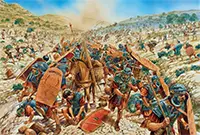The Second Jewish Revolt against Rome
The Second Jewish Revolt was more successful than the first but eventually ended up the same way, as a defeat against the might of the Roman Empire. Roman troops under Vespasian and Titus had sacked Jerusalem and destroyed the Temple in 66–70 during the First Jewish Revolt. A few emperors later, Hadrian allowed Jewish people to return to Jerusalem and rebuild the Temple. He didn't hold to his word, however, soon telling the Jews that they would have to move their temple to another site and then also telling them that they would have to leave their homeland and go to North Africa. 
The emperor, on his travels around his empire, visited that ancient city in 130 and then had it rebuilt the way he wanted it to look, not the way it had looked. He gave the city a Roman name, Aelia Capitolina, and then built a temple to Jupiter over the ruins of the Jewish Temple. Hadrian left in 132, and the nascent Jewish rebellion that had begun a decade earlier with a handful of guerrilla attacks that went nowhere, flourished into a large-scale revolt. This Second Jewish Revolt was also known as the Bar-Kokhba Revolt, after its strong, dynamic leader, Simon bar Kokhba. Jewish forces seized control of dozens of strongholds in Judea and nearly 1,000 towns and villages, among them Jerusalem. This revolt was more organized than the first one and gained more adherents, including a large number of fighters from other countries (not all of them Jews) offering to stand against Rome and its Judean governor, the cruel Tinneius Rufus. The leaders of the revolt had a nascent sovereign state, complete with a head of state, bar Kokhba, who was known as Nasi Israel ("Prince of Israel"). They signed contracts as a sovereign state and even issued coins with Hebrew slogans celebrating freedom. Hadrian sent a force of troops under the Syrian governor, General Publius Marcellus, to Judea; that force, too, was defeated by the determined Jewish rebellion. The response from Rome was swift and strong. Sextus Julius Severus, one of Rome's most competent generals, traveled from Britain to Judea, along with Hadrianus Quintus Lollius Urbicus, the former governor of Germania. The total force arrayed against the rebellious Jewish army was 12 Roman legions. Severus led a siege campaign against the Jewish soldiers ensconced in the fortresses that they had captured. Then, when the defenders were weak and exhausted, Roman soldiers struck, overrunning the defenses and the fortresses. Rome took back all of the towns and villages that Jewish soldiers had seized as well, and ground them to dust. Casualties were high on both sides. 
What turned out to be the final battle took place in the city of Bethar, Bar-Kokhba's headquarters, in 135. As before, Roman might eventually won out, even against a strong defense force occupying a virtually impregnable stronghold on a ridge overlooking a valley. Roman soldiers spared no one in the city. This Jewish revolt, too, resulted in great loss of life, with Jewish losses topping half a million. Roman soldiers quelled the Second Revolt just like they did the first one, and then the emperor banished whatever Jews were left and named the area Syria Palaestina. He went further, publicly burning the Torah and banning the observance of Judaism. |
|
Social Studies for Kids
copyright 2002–2024
David White





